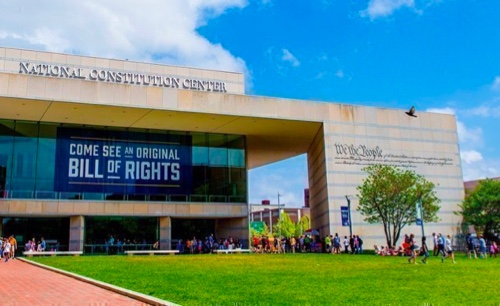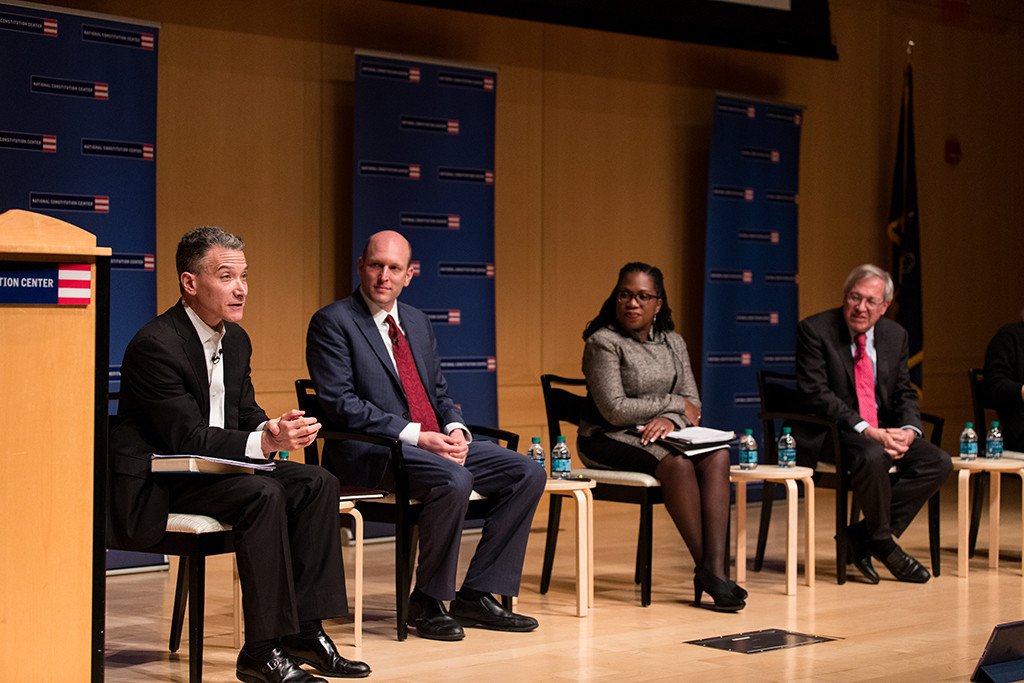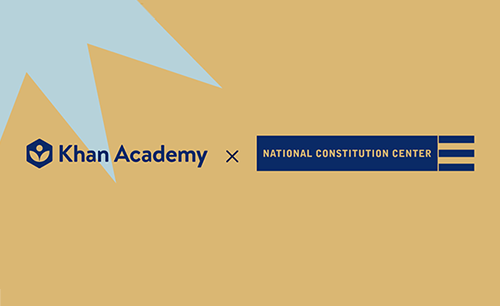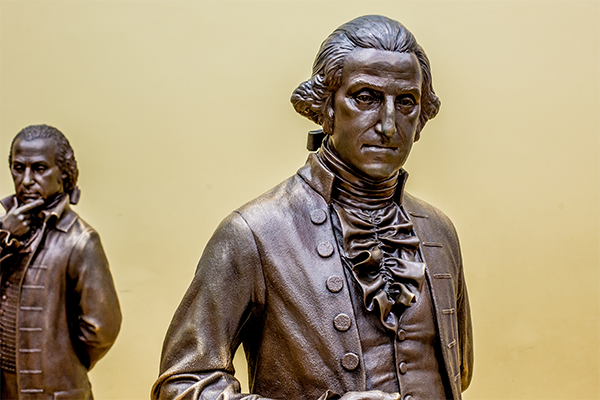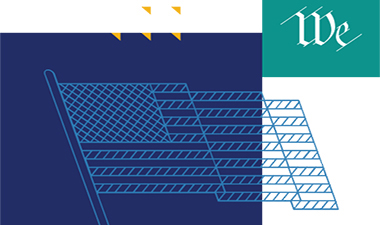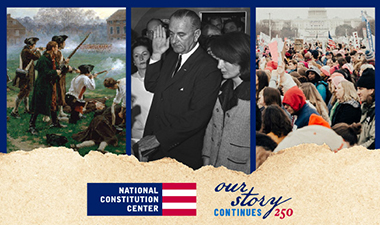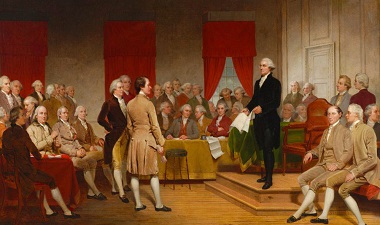At the National Constitution Center, we value civil dialogue, which empowers students to speak about constitutional and historical topics in ways that remain civil, respectful, and reflective. As you prepare to discuss these topics in your classroom, we encourage you to establish norms such as:
- Stay calm
- Listen patiently
- Listen actively
- Don’t speak twice until everybody has spoken once
You can find more support for establishing norms and civil dialogue practices in our Civil Dialogue Toolkit.
Media Asset
Constitution Daily Blog Post: How the Supreme Court ruled on press censorship cases after World War I, by Scott Bomboy, editor in chief at the National Constitution Center
Big Constitutional Questions
How does wartime test the limits of First Amendment freedoms? And, historically, how did the fallout from World War I lead to the emergence of a vision of robust First Amendment rights that would prove influential in the decades ahead?
Headline Story
After U.S. entry into World War I, Congress passed the Espionage Act of 1917 and then expanded it with the Sedition Act of 1918. Among other things, these laws punished printed speech that criticized the government, the war effort, or the Constitution. The postmaster general was empowered to block mailing of materials deemed harmful to national security.
Key Supreme Court cases followed: Schenck v. United States (1919) upheld penalties for speech believed to create “clear and present danger” and served as a reminder that First Amendment rights are not absolute. However, this period also featured dissents and concurrences that laid out a broad vision of First Amendment rights that would prove influential in the decades that followed, including Justice Holmes’s dissent in Abrams v. United States (also in 1919) and Justice Brandeis’s concurrence in Whitney v. California (1927). During this period, the Supreme Court also applied free speech protections to the states through the 14th Amendment in Gitlow v. New York (1925). This is part of the process known as incorporation that began to apply key Bill of Rights protections to state abuses. Finally, the Court also reaffirmed one core feature of the First Amendment: its protection against “prior restraints” (censorship before publication) in Near v. Minnesota (1931).
These decisions mark crucial turning points in press freedom.
Amendment / Clause Focus
- First Amendment
- Free Speech, Freedom of Press: protects the press from government interference
- Clear and Present Danger Doctrine
- Incorporation, 14th Amendment
- Prior Restraint Doctrine
Scholar Perspectives
|
Scholar |
Key Ideas & Quote |
Why It Matters |
|
Justices Oliver Wendell Holmes Schenck v. United States, 1919 |
“When a nation is at war, many things that might be said in time of peace are such a hindrance to its effort that their utterance will not be endured so long as men fight.” |
Holmes’s majority opinion shows how fear and crisis can narrow free speech protections. Even jurists can struggle to balance liberty and security. |
|
Justice Holmes Abrams v. United States, 1919 |
“But when men have realized that time has upset many fighting faiths, they may come to believe even more than they believe the very foundations of their own conduct that the ultimate good desired is better reached by free trade in ideas -- that the best test of truth is the power of the thought to get itself accepted in the competition of the market, and that truth is the only ground upon which their wishes safely can be carried out. That, at any rate, is the theory of our Constitution. It is an experiment, as all life is an experiment.” |
The Holmes dissent first expressed the “marketplace of ideas” theory that Stone and Volokh later expand on. Their modern scholarship grows directly from this early idea that democracy needs debate rather noisy, offensive, and even dissenting to survive. |
|
Justice Brandeis Whitney v. California 1927 |
“Whenever the fundamental rights of free speech and assembly are alleged to have been invaded, it must remain open to a defendant to present the issue whether there actually did exist at the time a clear danger; whether the danger, if any, was imminent, and whether the evil apprehended was one so substantial as to justify the stringent restriction interposed by the legislature” |
The Brandeis concurrence advocates for a powerful vision of robust free speech protection that would influence the Court for decades. |
Primary Source Spotlight (Embedded Excerpts)
First Amendment (1791): “Congress shall make no law...abridging the freedom of speech, or of the press...”
Schenck v. United States (1919): “clear and present danger” test
Abrams v. United States (Holmes dissent): “the best test of truth is the power of the thought to get itself accepted in the competition of the market.”
Whitney v. California (1927): provides a foundation for robust free speech protection
Gitlow v. New York (1925): First Amendment protections extended to states
Near v. Minnesota (1931): Prior restraints invalid except in narrow cases
Think, Talk, Create
Download Think, Talk, Create PDF
Student Questions
- How did the Sedition Act of 1918 affect free speech in the United States during World War I? How does this affect your understanding of the relationship between free speech and national security?
- Justice Louis Brandeis served on the Supreme Court from 1916 to 1939. During his tenure, the Court dealt with landmark cases dealing with free speech and free press. In your own words, what was Justice Brandeis’s position on free speech? Use evidence from the blog to support your response.
- What is the role of protections against prior restraints in the freedom of the press? How did rulings like Near v. Minnesota (1931) affect government censorship in its own time, and how does prior restraint continue to affect free expression today?
Student Choice Options
- Design a pamphlet that tells the story of free speech in the United States between 1917-1931.
- Review the Espionage Act of 1917 and Sedition Act of 1918. Then, create a Thin Slide with 1 word and 1 picture that synthesizes your understanding of the acts as they relate to free speech in times of war or national crisis.
- Teacher note: see the NCC’s Thin Slides 1-pager for more information on how to use this civic protocol in your classroom.
- This blog post outlines four important free speech and press cases during the World War I era: Schenck v. United States (1919), Abrams v. United States (1919), Gitlow v. New York (1925), and Choose one case and read the excerpts from the majority and dissenting opinions. Once you have read the case, engage in a class dialogue that responds to the constitutional question: What limits may the government place on press freedoms in times of war or national crisis? How do those limits compare to protections in peace time? Use evidence from the case to support your responses.
- Teacher note: You may choose to jigsaw this activity so you have a quarter of your class each read a case and come back together to exchange in civil dialogue about the constitutional question at hand.
Beyond the Headlines
- We The People Podcast: Can Government Officials Pressure Private Companies and Universities to Restrict Speech?
- National Constitution Center’s First Amendment Gallery: Exhibit exploration and Interactives
- Constitution 101
- Module 10, First Amendment (High School)
- Module 10, First Amendment (Middle School)
- Interactive Constitution
- Founder's Library
- Supreme Court Cases Library
- Near v. Minnesota (1931)
